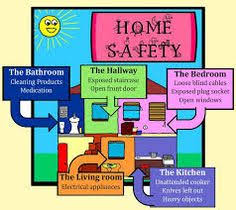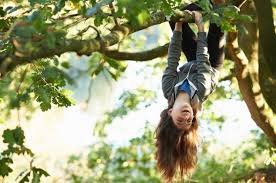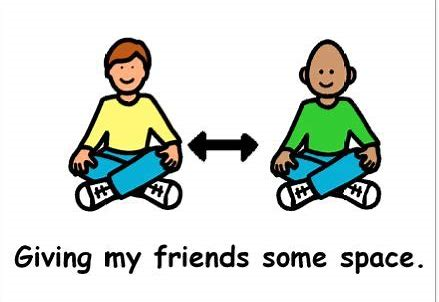A recent study by the American Journal of Public Health in examining national mortality data found that deaths caused by injury was almost as striking in those individuals with a diagnosis of autism. Their safety becomes even more of a priority because of their social, communication, and behavioral challenges.
SAFETY
The following was retrieved from – https://www.Safety.com/autism-Safety/
Most parents place their children’s safety as a top priority as a rule. But for parents of children with autism, the reality is that it can be even more difficult to keep your children safe from themselves as well as from others simply because of the nature of their disorder.
Keeping Your Child with Autism Safe at Home –The home can be a very dangerous place for any young child, but it can be even more dangerous for the child with autism. The difference is that the safety measures and precautions most parents implement for very young children may need to be in place for a much longer period of time for homes with children with autism.
< My Thoughts > “…dog may charge at the fence and bark loudly…”
Creating a calendar noting when certain checks and drills have been done… or should be done, may be wise. Then, be aware when new neighbors with pets move in. Their cat may like your child’s sandbox. Or, their dog may charge at the fence and bark loudly when they hear someone in the backyard. Just saying.
Phelan (2015) explains how the circumstances and one’s perception determines their reaction. She says that upon hearing a dog bark, many of us pay attention briefly then carry on. But a child having sensory issues or a negative experience with dogs could respond with a startle response, feeling anxious until s/he feels assured that they are out of harm’s way. For some with sensory issues that heightened state of alertness or excitability will most likely continue for some time after the incident.
Donkers, et al. (2015) talk about ‘mismatched’ reactions to environmental stimulus. They say that brain response can cause them to cover their ears because it triggers a memory, not necessarily because the sound is extremely loud and painful. My Sonny takes off running away from frightening sounds.
Bogdashina & Casanova (2016) quote Tito Muknopadhyay who describes his hyper-excitable state: “Panic took over my eyes, blinding them shut. It took over my ears, deafening me with the sound of a scream which was my own. I had no power to stop it.”
- Fire – As with all children, practicing for a house fire is an important safety measure. Some children with autism may become frightened of the loud alarms in your home, so you may want to purchase a smoke detector that records and plays your voice instead. Another fire safety tip is to take your child to your local fire department so he can become familiar with the fire persons. And the unfamiliar and strange looking gear they wear when they enter your home. Some children with autism handle stressful situations better when they have experience with them beforehand, in a calmer setting.
- Hot water – Sometimes children with autism struggle with sensory challenges, so they may be more at risk for being burned by hot water simply because they cannot feel hot and cold. One simple solution is to turn down the temperature on your hot water heater. If you have an older child with autism, you may want to practice turning on the hot water with the cold water. You may even put familiar visual stickers on the hot water knob to remind your child that it is a potential danger to him. Don’t forget to do this in the shower as well as on your sink faucets.
- Swimming Pools – If you own a pool, fence it in and make sure your gates are self-closing and latch above your child’s reach. Keep all pool toys and other interesting items out of the pool area when they are not being used. Ask your neighbors with swimming pools to follow these safety tips and make them aware of your child’s potential for wandering. A California research team studying those with ASD, pointed to drowning as the cause of the elevated death rate. So, pool and water safety lessons are crucial for children with autism.
2. We get him to imagine the transition several steps out, to help his brain “shift gears.”
3. We give him choices related to the change…
4. We attempt to generate buy-in for the change, by reminding him or getting him to recognize the positives that come from the change (Ex. Using flashlights & lanterns).
< My Thoughts > “…weather events…”
Where you live there are most likely regional and/or extreme ‘weather events’ such as heat waves, earthquakes, tornadoes, hurricanes, hail, tropical storms, blizzards, floods, etc. Sometimes Social Stories, visual supports, and/ or videos about what to do during such unusual and dangerous events can be helpful.
Safety issues change rapidly with toddlers. You can help protect your child from accidents and injuries by taking general safety measures around your home. Think ahead about what potentially dangerous situations will attract your child. Don’t forget to have a procedure for Public Areas with drinking fountains, restrooms, and play areas.
Supervise your child, but keep in mind that constant hovering over children can limit their experiences and confidence. Balancing supervision with safety precautions will help prevent accidents and injuries, as well as allow children to explore.” Retrieved from – https://www.webmd.com/parenting/baby/tc/health-and-Safety-birth-to-2-years-Safety-measures-around-the-home#1
< My Thoughts > “…where children explore.”
Never, ever underestimate your child’s ability or possible obsessive interest in something meant to discourage them. Especially as your child grows in size, interest, and skills.
Crawl around the house at your child’s height, at different times of the day and night. Sonny put my car keys in the broiler of the oven… it pulled out like a drawer. That also alerted me that he could use that drawer as a step up to reach the top of the stove. Ugh!
Other places danger lurks. Look for mold, loose or broken tiles or flooring. Are there tempting pet area, crates, cat climbers, or pet toys? Think of things that attract or repel your child. Go outside and check your yard for escape routes, and the safety of play equipment. Where might s/he run to hide from or engage with unusual sight or sounds.
Please, don’t delude yourself by thinking… Oh s/he will never, ever figure that out! In a moment of meltdown, panic, adventure, and/or just feeling obsessed to reach something… your child WILL find a way to escape or get what s/he sees and wants, or to escape from what is frightening them!
Here is a random list which comes from my experiences… I’m certain you will be able to add to it –
- Food pieces which will allow unsafe swallowing or ingestion (choke or plug airways… like hot dog and soft bread pieces). Or, something which looks like or is the color of food… medicine, laundry soap pods, gummy bear vitamins, and animal food/treats smelling like bacon or chocolate.
- Clothing Safety… not just for things to be sucked or swallowed, but for strangulation in a frantic attempt to remove. Sonny, who doesn’t ordinarily undress himself, can be lightening fast at stripping off every stitch of clothing if a drop of water gets on it. Smiles.
- Toys… where do you start with that? Dirt & water trapped inside to bring mold and germs. Pieces that come off, colors and paint that can be ingested. Especially paint & wheels on the toy cars they are so fond of ‘lining up’. Crayons that you find all over the house, left by your child or their siblings. Are there dangers from their sibling’s toys? Toys with magnets can be extremely dangerous. Research this.
- Water temperature of faucets and access to water heater, water softener, chemicals… or? Check with appropriate thermometer.
- Animal food, water, supplies, litter boxes, toys, treats… and so forth…
- Cleaning products – All chemicals must be locked up. Cleaning products should be locked in a SAFE location. You may want to put them in a locked area in the garage or basement, so they are NOT in the main living space of your home. Use of hand sanitizer should be supervised.
- Any firearms and accessories and the keys which lock them up can be extremely attractive to a child.
- All exit & entry points…house & garage doors, windows, doggy doors, stairs, ladders, attic or basement access, any crawl spaces. Doors – Key locks may be enough for some children with autism, but you may want to use door alarms to prevent your child from leaving your home without your knowledge. Keep your keys in a place out of your child’s reach. If your child has been known to wander. And remember, locks that keep your child in also keep you out.
- Older automatic garage doors that can’t be stopped from closing when object is in the way.
- Everything in the garage or carport area –prevent access to tools, machinery, cars, motorcycles, bikes. You know the devastating tragedies about children locking themselves in the car trunks. Heartbreaking.
- Appliances – Washers & dryers & dishwashers can be death traps. Freezers – If you own a chest-style freezer, keep it locked at all times. Storing the key in a safe place where your child cannot access it is a must.
- Pool Safety… this can be a long list in itself and should include hot tubs, plus connecting areas of danger.
- Surrounding areas. Alleyways, streets, and unkempt property or buildings, and abandoned vehicles with open windows, doors, and trunks.
- Install Smoke & Radon detectors which should be checked often for functioning and effectiveness. Upgrade to those with phone alert technology, if possible.
- Garden & yard & any playgrounds are places of virtual danger. Garden & yard machinery, supplies, tools, embedded sprinkler heads, broken fences. Check for unsafe sand, dirt, rocks, pebbles, animal feces.
- Surrounding streets, alleyways, bike and/or walking paths your child could get lost it.
- Noises can harm the supersonic hearing of babies and children. Garbage disposals, vacuums, food processors, computers, copiers, other technology. You may want to arm yourself with a decibel meter and become aware of hidden sounds you child hears which you may not.
- Cords (electric & otherwise), ear bud leashes, dog leads, even shoelaces can be dangerous.
- Visitors – As with any child, you should teach your child with autism the safety rules about opening the door to visitors. The old safety rule of NOT opening the door is especially important for a child with autism who has a severe language or speech delay or who is completely nonverbal. One way to communicate this rule to your child with autism is to create a social story with pictures to help explain the rules.
< My Thoughts > “…safety rules” about visitors…
Greetings may be taught to be a fist or elbow bump, instead of a handshake. Also, a child with sensory issues may severely react to the visitor’s perfume, aftershave, and/or terrifying intense eye contact. Don’t forget ‘Stranger/Danger’ rules and have a family ‘secret code’ before going anywhere with anyone.
One time, while stopped at a busy intersection, Sonny tried to help a vagrant open our car door. Thankfully, I had the car’s child-safety lock on his door.
Look at pictures to explore personal space concepts
Spend some time looking at pictures of people with your child. Talk about the body language the people are showing and whether or NOT good personal space is being observed.
Teach personal space language
Be sure to NOT only model personal space language, but to teach your kids some helpful personal space related language. Some example phrases could include:
- I need some space!
- That's too close!
- You can come closer!
- You're too far away right now.
- You're standing too close to me.
- Practice makes perfect, right? Kids can master the rules of personal space simply by practicing and repeating the skills over and over. Teach your kids the one-arm rule. That is, keep one arm length between you and your friend to maintain good personal space.
- Role playing is one way to practice personal space with your kids. You could even use their favorite toys or stuffed animals to demonstrate the concepts of personal space!
- Visual cues are super helpful for kids, especially those with autism and/or hyperlexia. You can use a visual clue like a hula hoop to demonstrate the invisible personal space bubbles that we all have. Or try holding a 6 ft. object between you and your child to show how much space is needed.
REFERENCES used here are:
Bogdashina, O. & Casanova, M. (2016). Sensory Perceptual Issues in Autism and Asperger Syndrome, Different Sensory Experiences – Different Perceptual Worlds; Second Edition: London; Philadelphia: Jessica Kingsley Publishers.
Donkers, F., Schiput, S., Baranek, G., et al. (2015). Attenuated Auditory Event-Related Potentials & Associations with Atypical Sensory Response Patterns in Children with Autism; Journal of Autism
Phelan, S. (2015). Understanding the Subtypes of Sensory Processing Disorder; Retrieved from nspt4kids.com › Resources › Occupational Therapy.





 RSS Feed
RSS Feed